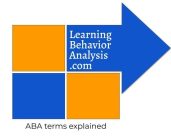A-1: Identify the goals of behavior analysis as a science (i.e., description, prediction, control) ©
Want this as a downloadable PDF? Click here!
Target Terms: Description, Prediction, Control

Description
Definition: A collection of facts about the observed event(s) that can be quantified, classified and examined for possible similarities to other known facts. (“I know what the behavior looks/sounds like.”)
Example in everyday context: A friend calls you up and asks how your day was. You begin to describe to your friend that you had a terrible day; you spilled your coffee all over your shirt and you were late to work. You follow up with maybe if you had woken up earlier, you would not have been rushed which is what led to the spilled coffee. You have provided your friend a quantifiable description of your terrible morning.
Example in clinical context: A parent comes to a clinic and is interviewed by the lead BCBA® about their child’s self-injurious and aggressive behavior. The parent describes to the BCBA that the aggressive behavior only occurs when the mother is interacting with the other siblings in the home. The parent also describes that the self-injurious behavior only occurs when the child is denied access to highly preferred activities. The parent has provided the BCBA with a description of the events that are associated with self-injurious and aggressive behavior exhibited by the child.
Example in supervision/consultation context: You are conducting a behavioral observation of a child in their math class. The child engages in crying behaviors. You observe that the behavior only occurs when the child is told by the classroom teacher that they “have to complete their math worksheet before they can play” with a preferred toy. You also observe that the child does not engage in crying behavior during any other subject, and only asks for access to the preferred toy during math class. This reflects an accurate description of the event(s) being observed.
Why it matters: Description is an important first step in science because the knowledge gathered through the systematic observation of an event of interest can help us ask better questions and develop the groundwork for further understanding about the event and/or similar events. If we do not accurately describe what is happening in ways that can be quantified and classified, we can’t move forward scientifically.
Prediction
Definition: Repeated observations reveal that observing other events can consistently result in accurately anticipating an outcome. (“I know when the behavior will occur.”)
Example in everyday context: You observe your neighbor collect their mail at the end of their very long driveway every afternoon. You also observe that on afternoons that it is raining, your neighbor carries an umbrella over their head. You can predict that each time it rains, your neighbor will carry an umbrella while they collect their mail.
Example in clinical context: A client on the inpatient unit engages in verbal aggressive behavior (e.g., screaming, cursing, verbal threats) toward staff and other patients on the milieu. After several days of observation, the nurse on the unit notices that each time the client requests and is denied access to alcohol and cigarettes, they engage in verbal aggression. The nurse predicts that each time the patient is denied access to alcohol and cigarettes, they will engage in verbal aggression.
Example in supervision/consultation context: You are observing a child in their classroom who engages in screaming and banging on their desk when the teacher does not pay attention to them. After several days of observing this same interaction, you can predict that when the child is not receiving attention from the teacher, they will engage in screaming and banging on their desk.
Why it matters: Prediction is an important aspect of science because it helps us establish relations between events. Prediction greatly expands how useful knowledge about a phenomenon can be for us. Remember, however that correlation does not mean causality. For example, strong correlation exists between hot weather and increased incidence of drowning deaths, but we cannot assume that hot weather causes people to drown. Causality means that A happened because of B. Correlation means that A and B move together in some way (either in the same or opposite directions).
Control
Definition: A specific change in one event can be reliably produced by scientific manipulation of another event. This change is not due to other factors or variables. (“I can turn this behavior on and off like a faucet.”)
Example in everyday context: Every morning you wake up and prepare your morning coffee. You push the “brew” button on your coffee maker, and coffee pours into the pot. In this instance, control of the production of coffee is reliably produced by pushing the “brew” button and not by any other action (e.g., opening the refrigerator or answering your cell phone).
Example in clinical context: A client in a residential treatment facility engages in self-injurious behavior, and has been referred for a functional analysis. During the analysis, the client does not engage in self injury during the play (control), attention, or tangible conditions. During the demand condition, however, the client engages in self injury every time they are presented with a demand. Removing the demand consistently results in termination of the self injurious behavior.
Example in supervision/consultation context: You have worked with a Life Skills teacher to support a child who initially requested food all day long. You and the teacher worked together and have taught the child to make requests for food using stimulus discrimination procedures. When a red cue card appears, requests for food are not honored and the child has learned not to request. When a green cue card appears, the child requests food, and these requests are granted. The absence of requests for food when the red cue card is present, and the increase in requests for food when the green cue card is present, demonstrates that the requesting behavior is under control of the red and green stimuli.
Why it matters: It is the ability to demonstrate control over two events (independent and dependent variables) that provides the kind of scientific understanding that is the most valuable and useful to the development of a technology for changing behavior.
When we say “control” in science, we mean it in the sense described above. The term “control,” however, can also bring up concerns about manipulating people or limiting their freedom in pursuit of a scientific agenda. It is possible to get so focused on controlling variables in a scientific sense that the overall goal (helping the client) is no longer the primary focus. Ethical ABA services seek to demonstrate control over relevant variables in order to develop the best individualized supports for clients.
